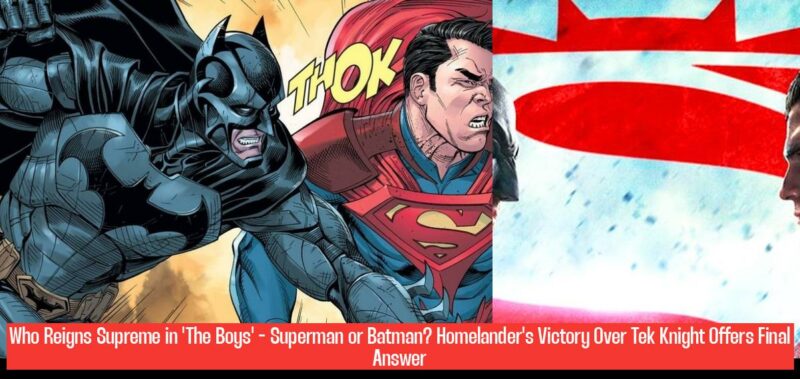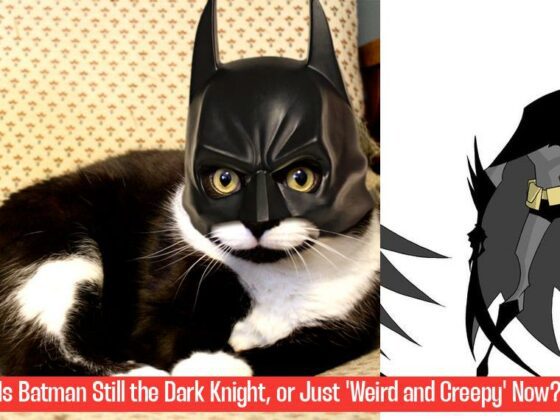‘The Boys’ delivers final verdict in Superman v/s Batman standoff
Tanvi Gupta
The fourth season of the acclaimed Amazon Prime Video series The Boys has finally put to rest the long-standing debate among DC fans about who is more powerful: Batman or Superman. The show, known for its satirical portrayal of traditional superhero narratives, introduces characters Tek Knight and Homelander as parodies of Batman and Superman, respectively. In a significant turn of events, Homelander emerges as the dominant figure, indirectly suggesting that Superman holds superior power over Batman.
Homelander asserts dominance over Tek Knight
In the sixth episode of Season 4, a pivotal interaction takes place between Homelander and Tek Knight at a Federalist Society gathering. This scene is a key turning point in the show’s depiction of the power dynamic between the two characters. From the beginning, Homelander dismisses Tek Knight’s assertion that they are “the two top heroes,” stating they are “not equals” and ridiculing Tek Knight’s inability to fly. This encounter underscores Homelander’s superiority, further suggesting that Superman is more powerful than Batman within at least The Boys‘s universe.
Homelander’s dismissive attitude towards Tek Knight’s claims of being a “top hero” reveals a clear hierarchy of power. By highlighting Tek Knight’s inability to fly, Homelander emphasizes the limitations of Batman’s abilities compared to Superman’s. This subtle yet significant comparison subtly reinforces the idea that Superman’s power and capabilities surpass those of Batman, resonating with the long-held belief among DC fans about the two iconic heroes.
The scene at the Federalist Society gathering provides a stark visual representation of the power dynamic between Tek Knight and Homelander. Homelander’s towering presence and arrogant demeanor effectively contrast with Tek Knight’s more grounded and tactical approach. This visual juxtaposition further emphasizes the disparity in their power levels, further solidifying the notion that Superman, represented by Homelander, holds the upper hand in a hypothetical showdown with Batman, represented by Tek Knight.
Moreover, the dialogue between Homelander and Tek Knight highlights a fundamental difference in their approaches to heroism. Homelander prioritizes brute force and intimidation, while Tek Knight relies on strategy and technology. This contrast reinforces the traditional portrayal of Superman as a powerful and unyielding force, while Batman is depicted as a strategic and resourceful master tactician. This subtle but powerful message resonates with the core characteristics of these iconic superheroes, adding another layer of depth to the show’s interpretation of their rivalry.
The scene at the Federalist Society gathering serves as a powerful visual representation of the power dynamic between Homelander and Tek Knight. Homelander’s towering presence and arrogant demeanor effectively contrast with Tek Knight’s more grounded and tactical approach. This visual juxtaposition further emphasizes the disparity in their power levels, further solidifying the notion that Superman, represented by Homelander, holds the upper hand in a hypothetical showdown with Batman, represented by Tek Knight.
Tek Knight’s downfall reinforces Homelander’s superiority
Tek Knight meets his end in the same episode, further emphasizing Homelander’s dominance. After being overpowered by Starlight and Kimiko at his “Tek Cave,” Tek Knight is killed not by The Boys, but by his butler, Elijah. This unexpected turn of events occurs after Elijah discovers Tek Knight’s involvement in Homelander and Sage’s plans. The series portrays Tek Knight as a pawn in Homelander’s game, underscoring the latter’s superior power and influence.
Tek Knight’s demise serves as a powerful testament to Homelander’s influence and control. The fact that Tek Knight is killed by his own butler, a seemingly insignificant character, underscores the extent to which Homelander has infiltrated and manipulated Tek Knight’s life. This manipulation highlights Homelander’s ability to control not only individuals but also entire systems, further cementing his position as a dominant force in the show’s universe.
The scene at Tek Knight’s “Tek Cave” reveals the extent to which Homelander’s influence extends beyond his direct interactions with Tek Knight. Homelander’s manipulation of Sage, a seemingly independent character, allows him to exert control over Tek Knight indirectly, highlighting his strategic prowess. This strategic manipulation highlights Homelander’s ability to control individuals through indirect means, demonstrating the extent of his power and influence.
More related > Marvel Executive Teases Kathryn Hahn’s Agatha Series as a Truly Terrifying Experience: A Spooky Halloween Show Awaits!
Furthermore, Tek Knight’s death at the hands of his own butler underscores the vulnerability of those who oppose Homelander. Despite Tek Knight’s impressive technological prowess and strategic mind, he is ultimately brought down by a seemingly insignificant character who has been manipulated by Homelander. This vulnerability reinforces the message that challenging Homelander’s authority comes with significant risks, effectively discouraging further opposition to his dominance.
The series portrays Tek Knight as a pawn in Homelander’s game, underscoring the latter’s superior power and influence. This portrayal serves as a powerful metaphor for the relationship between Superman and Batman, suggesting that Superman’s immense power gives him an advantage over Batman’s strategic brilliance. This interpretation resonates with the traditional portrayal of Superman as an unstoppable force, while Batman is depicted as a master strategist who relies on cunning and technology to counter his opponents.
Tek Knight’s lack of preparedness leads to his downfall
Despite Tek Knight’s realization that his party has been infiltrated, he fails to adequately prepare for an attack. This lack of preparation and inability to defend himself against his butler’s attacks proves that Tek Knight is not an intimidating presence, especially when compared to Homelander. His demise further cements Homelander’s position as the dominant figure in The Boys universe, reinforcing the notion that Superman holds superior power over Batman.
Tek Knight’s failure to anticipate the attack from his butler, despite his knowledge of the infiltration, highlights a significant flaw in his strategy. This lack of preparedness underscores the limitations of Tek Knight’s approach, highlighting the importance of anticipating threats and proactively addressing potential vulnerabilities. This flaw in Tek Knight’s strategy reinforces the idea that even the most brilliant and resourceful strategist can be vulnerable to unexpected attacks.
Tek Knight’s inability to defend himself against his butler’s attacks further emphasizes his vulnerability. This lack of preparedness and his failure to anticipate the threat from a seemingly insignificant character reveal a crucial flaw in his character. This vulnerability serves as a stark contrast to Homelander’s overwhelming power and ability to anticipate and counter any threats posed to his authority.
The scene at Tek Knight’s “Tek Cave” further reinforces the notion that Tek Knight is not an intimidating presence. Despite his impressive technological arsenal and strategic mind, he is ultimately brought down by a seemingly insignificant character. This vulnerability further highlights the disparity in power between Tek Knight and Homelander, reinforcing the idea that Homelander’s dominance is a result of his overwhelming power and ability to anticipate and counter any threats posed to his authority.
The series portrays Tek Knight’s demise as a direct consequence of his lack of preparedness and his inability to anticipate the threat posed by his butler. This portrayal underscores the importance of anticipating threats and proactively addressing potential vulnerabilities. This message resonates with the traditional portrayal of Batman as a master strategist who relies on preparation and foresight to counter his opponents. However, Tek Knight’s inability to do so reinforces the notion that even the most brilliant strategist can be vulnerable to unexpected attacks, especially when facing an opponent with overwhelming power, such as Homelander.
What is the final verdict in the Superman v/s Batman standoff in ‘The Boys’?
‘The Boys’ delivers the final verdict in the Superman v/s Batman debate by showcasing Homelander as the dominant figure, indirectly suggesting that Superman holds superior power over Batman.
How does ‘The Boys’ depict the power dynamic between characters Tek Knight and Homelander?
In a pivotal interaction at a Federalist Society gathering in Season 4, Homelander dismisses Tek Knight’s claims of equality, ridicules his inability to fly, and asserts dominance, highlighting Superman’s superiority over Batman.
What visual representation emphasizes the power difference between Tek Knight and Homelander in ‘The Boys’?
The scene at the Federalist Society gathering visually contrasts Homelander’s towering presence and arrogant demeanor with Tek Knight’s grounded and tactical approach, solidifying the notion that Superman, represented by Homelander, holds the upper hand over Batman, represented by Tek Knight.
What fundamental difference in heroism approaches is highlighted between Homelander and Tek Knight in ‘The Boys’?
Homelander prioritizes brute force and intimidation, while Tek Knight relies on strategy and technology, showcasing a contrast in their approaches to heroism and reinforcing the idea of Superman’s power superiority over Batman.



